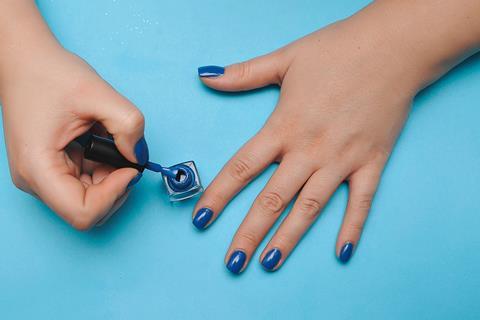From ancient glazes to modern acrylics, how the beauty industry nails applying science

Today, you can paint your nails almost every colour under the sun, from classic reds to wild rainbows and intricate patterns. But have you ever wondered about the chemistry behind the lacquers?
Cosmetic nail polish has been around for at least 5000 years. It originated in China and soon spread across the world. The ancient Egyptians used polish as an indicator of class status; workers wore clear polish, whereas wealthier individuals used henna – a red-orange dye from the henna plant, which contains lawsone (also known as hennotannic acid, C10H6O3). Ancient fashion icons used animal products, such as mixes of gum, beeswax and egg whites, to keep the glaze on their nails.
However, in 1917, Northam Warren introduced modern liquid nail polish as a way to protect people’s cuticles. This contained nitrocellulose, a film-forming polymer used extensively for painting cars (and in explosives). This polymer is soluble in organic, volatile solvents (most commonly ethyl acetate) that evaporate when exposed to air to leave behind the lacquer. To remove the polish, you just need another organic solvent to dissolve the polymer – typically, nail polish remover contains ethyl acetate or acetone.
Warren’s idea, combined with pigments to add colour, was a huge success and by the 1930s companies such as Revlon were making nail polish available to the masses. This introduced a host of other elements too: plasticisers, such as acetyl tributyl citrate, to make sure the lacquer isn’t brittle and doesn’t crack; stabilisers, such as benzophenone, to prevent colours fading; and adhesives to make the lacquer stick to the nail.
A dentist’s discovery
Then, in the 1950s, Fred Slack invented a new type of nail polish. Slack, a dentist, broke his fingernail and decided to fix it by using his dental repair kit. It was the origins of acrylic nails – artificial plastic tips made of poly(methyl 2-methylpropenoate), a transparent plastic used in everything from shatterproof glass to false teeth. False tips could be added with special pastes containing low levels of cyanoacrylate (better known as superglue) and other ingredients, such as methacrylate, to create longer nails or intricate shapes and designs.
Put this in context
Explore how consumer products technician, Robert develops desirable properties for consumer products, from cosmetics to chewing gum.
Building on the idea, gel nail formulas became available in the early 80s. Hard gels are polishes cured under ultraviolet (UV) light to give a hard-wearing, long-lasting coating. Unfortunately, you can develop a severe allergy to methacrylate, which is used in the majority of gel and acrylic polishes. However, a few hypoallergenic alternatives exist. The best way to avoid developing a methacrylate allergy is to not use nail polishes containing it. Although it is believed that home UV lamps that are not of the correct wattage or wavelength are a contributing factor because the acrylates do not dry properly and leave the surrounding skin exposed.
With manicures being big business, it’s unsurprising companies are constantly looking for ways to innovate and outcompete each other. Another popular style, that also takes inspiration from the automobile industry, is nail wraps – pieces of fibreglass or silk fabric stuck to the surface of the nail. And, the world’s most expensive nail polish is Azature white diamond: a lacquer made from 98 carats of crushed diamonds. It’s unlikely you’ll get to use it to bling up your nails though: a single bottle costs $1 million (roughly £780,000).
Waiting for your nail polish to dry? Watch this:
@royalsocietyofchemistry Today, you can paint your nails almost every colour under the sun. But have you ever wondered about the chemistry behind the lacquers? Ross explains some of the chemistry behind your colourful nails #Nails #LearnOnTikTok #MakeUp #Barbie ♬ Fresh Nail - DJ BAI
Kit Chapman
Waiting for your nail polish to dry? Watch this TikTok: bit.ly/44aP5YB














1 Reader's comment